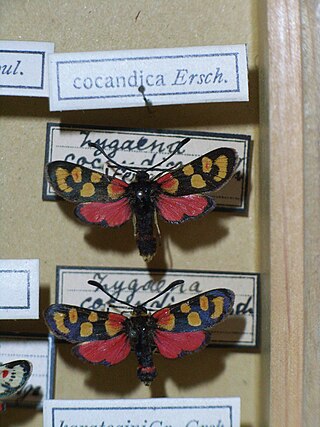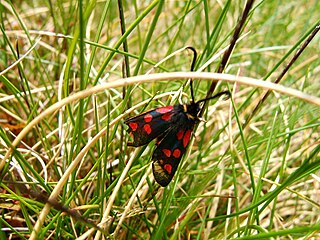
Zygaena fraxini is a moth of the family Zygaenidae.It is a Palearctic confined to Western Asia.

Zygaena purpuralis, the transparent burnet, is a moth of the family Zygaenidae.

Zygaena occitanica, the Provence burnet, is a moth of the Zygaenidae family. It is found from the Algarve and southern Spain up to the eastern parts of the Cantabrian Mountains then to southern Russia and the Caucasus and east to the western fringe of Central Asia.

Zygaena cocandica is a moth of the family Zygaenidae. It is found in Uzbekistan, Tajikistan and Kyrgyzstan. In Seitz it is described as "A very remarkable form with yellow spots on the forewing, only the basal ones being shaded with red, it has sometimes an entirely red abdomen ab.karategini Gr.-Grsh., from Buchara" Also in Seitz as erschoffi Stgr. it is described as having "spots 5 and 6 often widely separate, standing side by side rather than one below the other; collar and 1-2 abdominal segments red, sometimes also the shoulders, as in our last figure: Pamir". The length of the forewings is about 12 mm.

Zygaena cambysea is a moth of the family Zygaenidae. It is found in the Middle East, including Iran. It is rosy-red like cuvieri, but differs in the body being entirely black, without red collar and belt. In the form rosacea Rom. from Armenia the spots of the forewing are so merged that the wings appear almost evenly carmine.

Zygaena brizae is a species of moth in the Zygaenidae family. It is found in France, Italy, Austria, the Czech Republic, Poland, Slovakia, Hungary, the Balkan Peninsula, Moldova, Ukraine, Russia, Turkey and Georgia.

Zygaena punctum is a species of moth in the family Zygaenidae. It is found in Poland, the Czech Republic, Slovakia, Austria, Slovenia, Italy, the Balkan Peninsula, Moldova, Ukraine, Russia and Turkey.

Zygaena anthyllidis is a species of moth in the Zygaenidae family. It is found in France and Spain.

Zygaena rhadamanthus is a species of moth in the Zygaenidae family. It is found in France, Spain, Portugal and Italy.

Zygaena magiana is a species of moth in the Zygaenidae family. It is found in Central Asia.

Zygaena truchmena is a species of moth in the Zygaenidae family. It is found in Central Asia.

Zygaena olivieri is a species of moth in the Zygaenidae family. It is found in Syria, Armenia and Georgia. Seitz describes it -In olivieri Boisd. (7h) not only the collar and 2—8 abdominal segments are red but also the patagia, the red spots of the forewing being very large; from Syria and Armenia.In subspecies Z. o. laetifica Herrich-Schäffer, 1846 the pairs of spots on forewing are separate. — In Z. o. ganimedes Freyer, [1851] from Amasia, the penultimate pair of spots and the apical patch are rather broadly connected and the red markings of the forewing have a white edge of about 1 mm width.

Zygaena cuvieri is a species of moth in the Zygaenidae family found from Armenia and Syria to Central Asia. In Seitz it is described as follows: "This large fine Burnet has rosy-red wings, the forewing being divided into 3 areas by two black-grey bands; a broad collar and a rosy abdominal belt. Inhabits Anterior Asia, from Syria through Mesopotamia to Turkestan."

Zygaena manlia is a species of moth in the Zygaenidae family. It is found in Armenia, Turkey and Iran.In Seitz it is described as - "Similar to Zygaena cuvieri and with an equally broad rosy red collar and abdominal belt, but the blackish bands separating the red areas of the forewing are much broader, the distal area being represented by an irregular half-divided patch. North Persia"

Zygaena haberhaueri is a species of moth in the Zygaenidae family. It is found in Armenia and Georgia In Seitz it is described With red collar, but without red belt. On forewing obliquely from costa to anal angle an evenly wide greyish black band separating a triangular marginal patch from the red area of the wing, this area moreover being costally incised at the basal third or divided by a slight band. In Armenia, apparently in localities where for a long while past no collections have been made.

Zygaena felix is a species of moth in the Zygaenidae family. It is found in south Spain and the Atlas Mountains. In Seitz it is described. — In felix Oberth., from Algiers and South-West Spain, the black spots are more or less confluent, the red ground-colour along the distal margin being sometimes separated as a sock-like halfmoon. The white edges are usually altogether absent, or there are only feeble vestiges of them — In ab. faustula Stgr.-Reb.[ now Z. felix ssp. constantinensis Reiss & Tremewan, 1964] on the contrary the black spots are distinctly edged with yellowish white. — Lastly, ab.mauretanica Stgr. [now Z. felix ssp. constantinensis Reiss & Tremewan, 1964] (8a) has a red belt. — The 3 forms tly exactly at the same time and the same places; I found them frequently united in copula. They are extremely common throughout June on nearly all the heights of the Atlas Mts., sometimes the one sometimes the other form being prevalent in the various flight-places.

Zygaena loyselis is a species of moth in the Zygaenidae family. It is found in the Atlas Mountains.

Zygaena favonia is a species of moth in the Zygaenidae family. It is found in the Atlas Mountains, .In Seitz it is described Z. favonia Frr. (4g). This form belongs to a group of North African Burnets the pattern of the forewings of which reminds one much of the preceding species [ Zygaena sarpedon, while the abdomen is red from the middle nearly to the tip, which gives the insect a characteristic aspect and renders it easy to recognize even when it flies quickly past. The whole of Mauretania, everywhere common — ab. vitrina Stgr. (4g) [ now Z. favonia ssp. valentini Bruand, 1846], which I found only at very limited localities, for instance near Constantine and at the cemetery-wall near Batna, is easily differentiated by the transparent wings. -ab. staudingeri Aust. (4f) [ now Z favonia Freyer, 1844] is similar, but has only a narrow abdominal belt, so that one might mistake the for a small loyselis, if it did not lack the red collar of the latter. — The insect described by Bruand as valentini [ now Z. favonia ssp. valentini Bruand, 1846], in which the red spots are enlarged, may possibly belong to an analogous favonia-form. — The finest form of this group is thevestis Stgr. [now Z. favonia ssp. thevestis Staudinger, 1887 (4f), in which there is a large lobate subapical patch. — All these varieties occur all over Mauretania, on hills, in dry beds of rivulets, and on waste ground. The commonest form is favonia, which is found in June on nearly all the thistles growing at the road-sides and in the fields. The females have an extraordinarily thick body, and apparently scarcely take to the wing before copulation.

Zygaena niphona is a species of moth in the Zygaenidae family. It is found in the east Palearctic. In Seitz it is described Z. niphona Btlr. (6e). The only Burnet from East Asia. Rather large, sparsely scaled, 5 spotted, with rather wide red abdominal belt. Club of antenna strongly incrassate at apex. The insect has the appearance of a large meliloti, but the body is strong and robust, the flight however being nevertheless not at all fast. Though the species varies considerably, some specimens being 6 spotted and resembling therefore Z. peucedani, there are no local races. The abdominal belt occupies mostly 2 segments, but is sometimes restricted to one segment, the posterior portion of the abdomen being occasionally all red. The species is widely distributed in Japan, especially at low altitudes of the central mountains, near and on the Fujisan; probably more sporadic in Amurland, since Graeser did not meet with it.

Zygaena separata is a species of moth in the Zygaenidae family. It is found in Southern Fergana ( Uzbekistan). Zygaena separata was described as ab. separata Stgr. of fraxini. It differs in that the distal spots are narrowly but distinctly separated from one another.

















